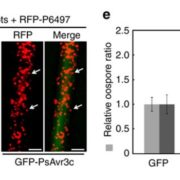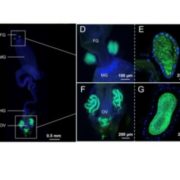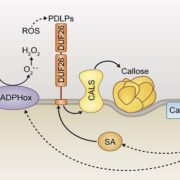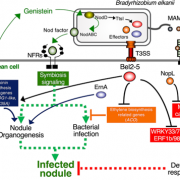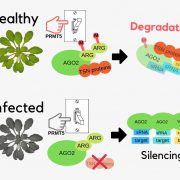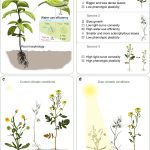PEN3 and PDR12 secrete camalexin to the apoplast to limit pathogen growth in Arabidopsis (Plant Cell)
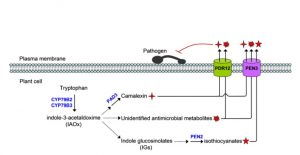 Phytoalexins are important antimicrobial compounds that plants synthesize to fend off invading pathogens. In the Brassica family, the tryptophan (trp)-derived phytoalexin ‘camalexin’ provides broad-spectrum resistance against bacterial, fungal, and oomycete pathogens. The regulation of camalexin biosynthesis during pathogen attack is well described, however a mechanistic understanding of its transport towards invading pathogens was previously unresolved. In a new study, He et al. leveraged the role of the PDR (Pleiotropic Drug Resistance) family transporter PEN3 (Penetration3), previously implicated in the secretion of an unknown complement of phytoalexins, to identify transporters involved in the secretion of camalexin in Arabidopsis. The authors first profiled the expression of each PDR family member during infection with the fungal pathogen Botrytis cinerea using qRT-PCR and GUS reporter analyses, revealing a strong upregulation of PEN3 (PDR8) and PDR12. Phenotypic analyses demonstrated a redundant role for PEN3 and PDR12 in providing resistance to B. cinerea, such that pen3/pdr12 double mutants were drastically more susceptible to infection than either single mutant or wild-type controls, and Botrytis-infected pen3/pdr12 double mutants contain abnormally high intracellular levels of camalexin due to significant defects in its secretion into the apoplast. Consistent with these results, pen3/pdr12 seedlings exhibited an enhanced sensitivity to exogenous camalexin treatment. Further biochemical analyses supported a role for PEN3 and PDR12 in transporting an unknown set of additional trp-derived metabolites and supported the well-established role for PEN3 (but not PDR12) in the transport of indole-glucosinolates (IGs). This work furthers our current understanding of phytoalexin transport during pathogen infection in Arabidopsis and provides novel insight into the role of PDR family transporters in plants. (Summary by Phil Carella) Plant Cell 10.1105/tpc.19.00239
Phytoalexins are important antimicrobial compounds that plants synthesize to fend off invading pathogens. In the Brassica family, the tryptophan (trp)-derived phytoalexin ‘camalexin’ provides broad-spectrum resistance against bacterial, fungal, and oomycete pathogens. The regulation of camalexin biosynthesis during pathogen attack is well described, however a mechanistic understanding of its transport towards invading pathogens was previously unresolved. In a new study, He et al. leveraged the role of the PDR (Pleiotropic Drug Resistance) family transporter PEN3 (Penetration3), previously implicated in the secretion of an unknown complement of phytoalexins, to identify transporters involved in the secretion of camalexin in Arabidopsis. The authors first profiled the expression of each PDR family member during infection with the fungal pathogen Botrytis cinerea using qRT-PCR and GUS reporter analyses, revealing a strong upregulation of PEN3 (PDR8) and PDR12. Phenotypic analyses demonstrated a redundant role for PEN3 and PDR12 in providing resistance to B. cinerea, such that pen3/pdr12 double mutants were drastically more susceptible to infection than either single mutant or wild-type controls, and Botrytis-infected pen3/pdr12 double mutants contain abnormally high intracellular levels of camalexin due to significant defects in its secretion into the apoplast. Consistent with these results, pen3/pdr12 seedlings exhibited an enhanced sensitivity to exogenous camalexin treatment. Further biochemical analyses supported a role for PEN3 and PDR12 in transporting an unknown set of additional trp-derived metabolites and supported the well-established role for PEN3 (but not PDR12) in the transport of indole-glucosinolates (IGs). This work furthers our current understanding of phytoalexin transport during pathogen infection in Arabidopsis and provides novel insight into the role of PDR family transporters in plants. (Summary by Phil Carella) Plant Cell 10.1105/tpc.19.00239



